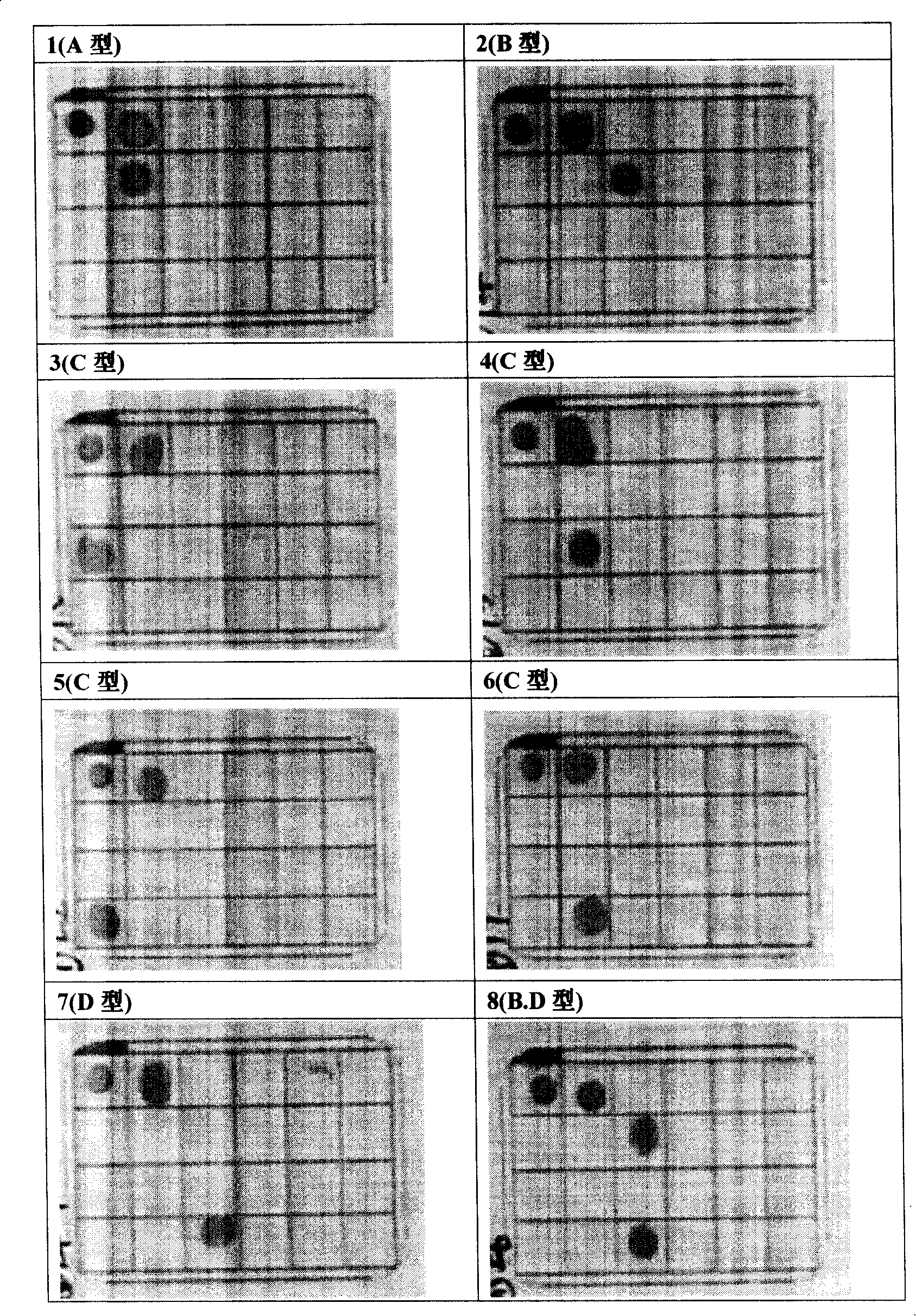Subtype detection method and reagent kit for hepatitis B virogene
A technology of hepatitis B virus and genotyping, which is applied in biochemical equipment and methods, microbial measurement/testing, DNA/RNA fragments, etc., can solve the problems of low sensitivity, high price, low specificity, etc., and achieve experimental operation Convenience and speed, shorten incubation time, increase concentration and hybridization efficiency
- Summary
- Abstract
- Description
- Claims
- Application Information
AI Technical Summary
Problems solved by technology
Method used
Image
Examples
Embodiment 1
[0107] Embodiment 1: Preparation of sample target nucleic acid
[0108] Use a disposable sterile syringe to extract 2 ml of venous blood from the subject, inject it into a sterile dry glass tube, and place it at room temperature (22-25°C) for 30-60 minutes. Centrifuge at 1500rpm for 5 minutes; absorb 100μl of serum from the upper layer and transfer to a 1.5ml sterilized centrifuge tube. Then add an equal volume of concentrated DNA solution into the centrifuge tube and mix well, centrifuge at 12000rpm for 10 minutes, and collect the precipitate at the bottom of the tube. Add 20 μl of conventional DNA extraction solution to the precipitate, mix well, bathe in boiling water for 10 minutes and centrifuge at 12000 rpm for 10 minutes. Take 2 μl of the supernatant as a template for the PCR reaction. In the formulation of the concentrated solution, we have used different concentrations of polyethylene glycol (3% to 10%) and sodium chloride in combination, and 3% to 10% of polyethyle...
Embodiment 2
[0109] Embodiment 2: PCR amplification of target nucleic acid
[0110] Take several tubes of PCR reaction solution for a single tube, add 2 μl template (or negative and positive standards) directly, mix well, centrifuge briefly (3 seconds), and put each reaction tube into the PCR machine. Amplify according to the following conditions: pre-denaturation at 93°C for 6 minutes, followed by 10 cycles of amplification at 93°C for 30 seconds, 58°C for 40 seconds, 72°C for 45 seconds, 93°C for 30 seconds, 56°C for 40 seconds, and 72°C for 45 seconds. Add 10 cycles, 93°C for 30 seconds, 55°C for 40 seconds, 72°C for 45 seconds for 15 cycles of amplification, a total of 35 cycles; finally, keep warm at 72°C for 7 minutes. The amplified products were detected by 2% agarose gel electrophoresis (see attached figure 2 ).
Embodiment 3
[0111] Example 3: Reverse dot blot detection of samples of four known genotypes
[0112]Before hybridization, mix hybridization solution I (2×SSC-0.1% SDS) with hybridization solution II and preheat to 45°C for use. According to the number of samples to be tested, take a corresponding number of 1.5ml centrifuge tubes, add 0.65ml hybridization solution I to each tube and preheat to 42°C. After the PCR amplification product was denatured at 98°C for 8 minutes, it was placed in an ice-water mixture for 8-10 minutes. Then take 1000 μl hybridization solution I+2 μl solution I (1000:2) mixed solution as the binding solution and store it at 4°C for later use, and take the mixture of solution II:solution III:solution IV (1900:200:1) (19ml solution II+2ml Solution III + 10 μl solution IV) was used as a chromogenic solution protected from light for later use.
[0113] Before hybridization, fill the reaction chamber with distilled water, place the metal perforated plate, and turn on th...
PUM
 Login to View More
Login to View More Abstract
Description
Claims
Application Information
 Login to View More
Login to View More - R&D
- Intellectual Property
- Life Sciences
- Materials
- Tech Scout
- Unparalleled Data Quality
- Higher Quality Content
- 60% Fewer Hallucinations
Browse by: Latest US Patents, China's latest patents, Technical Efficacy Thesaurus, Application Domain, Technology Topic, Popular Technical Reports.
© 2025 PatSnap. All rights reserved.Legal|Privacy policy|Modern Slavery Act Transparency Statement|Sitemap|About US| Contact US: help@patsnap.com



